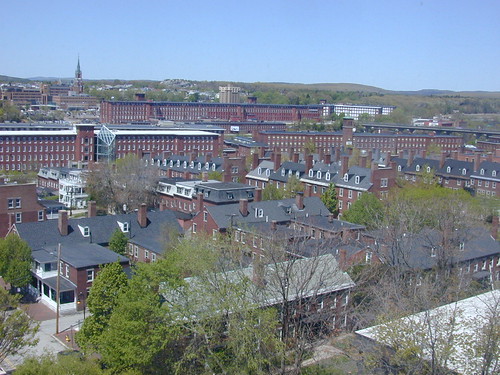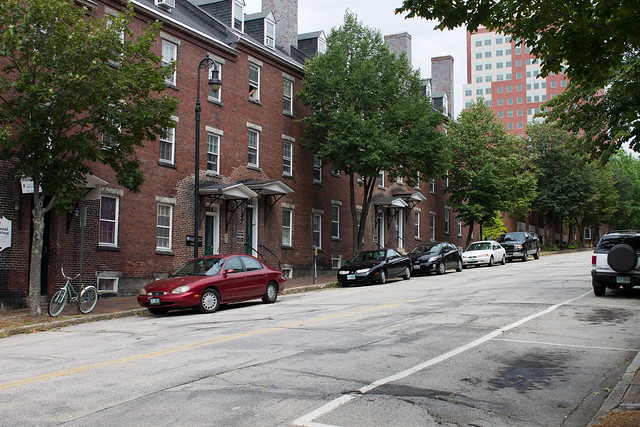FrankLloydMike
Active Member
- Joined
- Jun 24, 2010
- Messages
- 514
- Reaction score
- 0


Illustrated skylines of Manchester and Portland by Joan Breault
An interesting comparison of Manchester and Portland in today's Union Leader:
McCune’s Manchester
The Queen City vs. the Forest City
Adam McCune
I bellied up to the bar at the Great Lost Bear in Portland, Maine. There was a typical lunch crowd; small groups huddled around burgers, quietly eating and sipping on cold beverages.
Right above my head was a picture of Michael Jackson.
Not the singer, the British beer writer. The place is a beer bar and its striking likeness to Manchester’s Strange Brew Tavern got me thinking about the similarities and differences between two of New England’s jewel cities.
Obviously, Portland has the leg up in tourism.
Beaches and islands nearby help that. According to Portland’s Downtown District, the population swells from 66,000 to nearly two million on a busy summer day. Perhaps the added foot-traffic gives more credence to their art and culture status.
Come to think of it, I’m kind of bothered by the idea that Portland is known as a foodie and art city and Manchester isn’t....yet.
“I do see Manchester being recognized for our incredible variety of amazing dining destinations and arts and cultural venues,” Samantha DiPrima, Director of Marketing and PR for Intown Manchester told me.
“The fact that Portland is on the seacoast and is a tourist destination may be why some see it as being more recognized for assets that we have in common.”
That may be true. But what we make up for in famous funny alumni.
I find it somewhat ironic that Boston’s Comedy Connection has a satellite operation in Portland, yet the likes of Adam Sandler, Sarah Silverman and Seth Meyers all have roots here. Manchester is funny, if only by associations and our double-sided dead-end Elm Street.
Walking along Congress Street in Portland gives you a similar feel to Elm Street in the Queen City. There is a specific shade of red from the bricks that highlights both cities, and while Manchester’s mill city roots certainly birthed more brick, you can see remnants and traces of it in Portland.
The New Hampshire Institute of Art is blossoming in this city, highlighted by their recent expansion and Intown Manchester’s banner campaign, which relaunched this week with the help of photography from students. It certainly rivals what Portland offers at Maine College of Art.
Portland’s seaport also holds a bounty of beautiful islands just a ferry ride away. All we get in equivalence is an island beyond the dam on the Merrimack. Out of reach except for a few bored teenagers and some adventurous kayakers.
Both cities have rival baseball and hockey teams, and both host large venues for music and entertainment.
But even though I can admire and respect Portland, I still get an odd sense of phoniness while I’m there. There are some in the city that are simply putting on airs, like a wanna-be Boston.
And I guess that’s the real difference between the cities.
Manchester seems more real to me. They may have the fantastic wonder of Peaks Island, or the beauty of a massive ship coming into port, but we have something more palpable. There is substance here, and not the kind that dwindles from two million to 66,000 just because it might snow.
DiPrima puts it best: “Manchester is unique, diverse and vibrant. People like to try and compare different downtowns and hyperfocus on what one may have that the other doesn’t and don’t spend enough time celebrating what we do have as individual communities that make us unique and incomparable to others.”
I don't agree with all of it. I don't get a feeling of phoniness in Portland (or Boston, for the most part). Portland is certainly hipper, and maybe that's what he's getting it--I can definitely see a sense of "putting on airs" by hipsters, and restaurants and boutiques with built-in instant personality, which I guess could be construed as phoniness sometimes--but as much as that can annoy me in Cambridge or Boston, I think it's a very important component in making cities like Manchester and Portland more interesting, lively places to live and visit. Manchester could use a bit more of it--and judging by the growing number of art students, hip restaurants and even fixed-gear bikes I see in the city, I think it's getting hipper.
Manchester has some great natural assets--the Merrimack River, Massabesic Lake, the Uncanoonuc mountains, and even more mountains, rivers, lakes and beaches a short ride away--but they are currently underutilized and under-promoted. I've said this before, but Manchester could do a much better job of promoting itself as a good place to live (and an easy daytrip from Boston) for outdoorsy types if it developed or encouraged boat rentals on the river and Massabesic, rock climbing on Rock Rimmon and the continued development of the trail network, among other things.
Still, it will never have the same general tourism draw of Portland or Portsmouth. No part of Manchester is as quaint as Market Square or the Old Port, and lovely as the river is, it's no ocean. As McCune alludes to, tourism is huge in making a relatively small city like Portland feel much bigger, and attracting the sort of restaurants, shops and general feel that allow it to be compared (favorably or unfavorably) to Boston.
Without the natural asset of the ocean and the historical asset of narrow, meandering streets, Manchester needs to work a bit harder to attract tourists, as well as residents looking for an urban alternative to Boston. It should continue to bill itself as a good place to do business and as a good place for business travelers and conventions--which judging by the major hotels in the city, seem to be its overnight bread and butter. The city has also been doing a better job of attracting daytrippers to baseball games, concerts, shows and museums, as well as the downtown dining scene that attracts people from surrounding towns.
Whereas in Portland and Portsmouth, I get the sense that greater livability for residents largely followed an increase in tourism, I think in Manchester the opposite may turn out to be true. If Manchester can make its downtown and city center neighborhoods (Rimmon Heights, the lower North End and Straw/Smyth seem best positioned to be the forerunners here) more attractive places for young people and middle-income families (the type currently moving to Boston or the neighboring suburbs) to live, continue to grow the presence of colleges in the city, and continue to improve the dining and shopping scene downtown, then I can see it growing as a minor tourist destination in the coming decades.
Manchester lost too many vital buildings and neighborhoods to urban renewal (downtown used to continue all the way to Valley Cemetery, for instance), and partly as a result it has lost too many young people, middle-income families and other residents to neighboring towns and other cities. It needs to act like the city it is--through better planning and zoning, along with better urban amenities like public transit--and build upon the strengths and history it has in order to restore its sense of urbanism, and draw new and former residents back.
And part of that means that it will need to get a bit hipper, but that's okay with me. If Manchester is to continue to grow into (or I would say return to being) a real city, it's going to need to be able to attract all sorts of people for all sorts of reasons.
As a side note and plug, please vote for LivableMHT's Urban Livability Awards if you haven't already... among the categories are Manchester's greatest strength, its greatest natural asset, and its best urban role model (Portland is an option).


